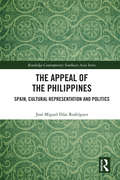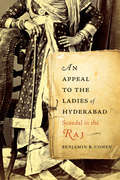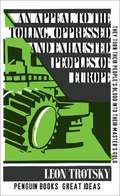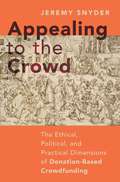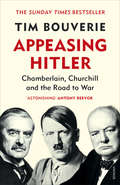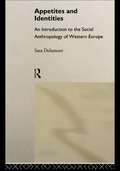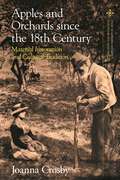- Table View
- List View
The Appeal of Art in Modernity (Classical and Contemporary Social Theory)
by Michael SymondsThis book explores the place of art in the modern world, but instead of asking what art is, it begins with the question of art’s appeal in modernity. Why is the appellation ‘art’ so desired for movies, food, and fashion, for example? Why is there the assumption of esteem when someone calls themselves an ‘artist’? On the other hand, why is modern art so often seen as, at best, difficult and, at worst, not, in fact, art? Engaging with a broad range of theory, the author draws on the thought of Max Weber to offer an account of art’s widespread appeal in terms of its constituting a self-contained value-sphere of meaning, which provides a feeling of tremendous salvation from the senseless routines of modern life. In this way, major theories on aesthetics in philosophy and sociology – including those of Kant, Hegel, Adorno and Bourdieu – are critically recast and incorporated into an overall explanation, and fundamental questions concerning the relation of art to politics and ethics are given innovative answers. A fresh examination of the development of the aesthetic sphere that shows how art came to be regarded as one of the last bastions of freedom and the highest human achievement, and, also, how it became increasingly isolated from the rest of society, The Appeal of Art in Modernity will appeal to scholars of philosophy, social theory, and sociology with interests in art, modernity, and Weber.
The Appeal of the Philippines: Spain, Cultural Representation and Politics (Routledge Contemporary Southeast Asia Series)
by José Miguel Díaz RodríguezThis book examines the different means through which Spain has revisited its ex-colony - the Philippines - since 2000. Focusing on several major exhibitions organised in the period 1998-2017, the ‘poetics’ (narratives and meaning) and ‘politics’ (institutional power) of Spanish representations of the Philippines are critically examined. Even though Spain’s intention was to offer a fresh and updated look at the Philippines through the events organised, there was also a tendency to refer to and recreate a colonial past, posing important questions about the continuity of conceptions concerning the old Spanish Empire in the 21st Century. Díaz Rodríguez further analyses Spanish cultural policy concerned with cultural promotion outside Spain and, in particular, in the Philippines. He considers the Spanish official approach to cultural exchange in the Philippines and the consequences of particular intercultural events supported by Spanish institutions in the Philippines. This is evidenced by unique data gathered from a number of interviews conducted by the author with Spanish and Filipino artists and cultural workers. His conclusions contribute to the understanding of the transnational movement of culture, including cultural representation, arts funding, and the links between politics and the arts.
The Appeal of the Philippines: Spain, Cultural Representation and Politics (Routledge Contemporary Southeast Asia Series)
by José Miguel Díaz RodríguezThis book examines the different means through which Spain has revisited its ex-colony - the Philippines - since 2000. Focusing on several major exhibitions organised in the period 1998-2017, the ‘poetics’ (narratives and meaning) and ‘politics’ (institutional power) of Spanish representations of the Philippines are critically examined. Even though Spain’s intention was to offer a fresh and updated look at the Philippines through the events organised, there was also a tendency to refer to and recreate a colonial past, posing important questions about the continuity of conceptions concerning the old Spanish Empire in the 21st Century. Díaz Rodríguez further analyses Spanish cultural policy concerned with cultural promotion outside Spain and, in particular, in the Philippines. He considers the Spanish official approach to cultural exchange in the Philippines and the consequences of particular intercultural events supported by Spanish institutions in the Philippines. This is evidenced by unique data gathered from a number of interviews conducted by the author with Spanish and Filipino artists and cultural workers. His conclusions contribute to the understanding of the transnational movement of culture, including cultural representation, arts funding, and the links between politics and the arts.
An Appeal to the Ladies of Hyderabad: Scandal in the Raj
by Benjamin B. CohenBenjamin Cohen tells the dramatic story of Mehdi Hasan and Ellen Donnelly, whose marriage convulsed high society in nineteenth-century India and whose notorious trial reverberated throughout the British Empire, setting the benchmark for Victorian scandals. In the struggle of one couple, he exposes the fault lines that would soon tear a world apart.
An Appeal to the Toiling, Oppressed and Exhausted Peoples of Europe (Penguin Great Ideas Ser.)
by Leon TrotskyWhether calling for an end to the capitalist system, addressing the crowds after the Russian Revolution, or attacking Stalin during his years of exile, Trotsky’s speeches give an extraordinary insight into a man whose words and actions determined the fates of millions. Throughout history, some books have changed the world. They have transformed the way we see ourselves – and each other. They have inspired debate, dissent, war and revolution. They have enlightened, outraged, provoked and comforted. They have enriched lives – and destroyed them. Now Penguin brings you the works of the great thinkers, pioneers, radicals and visionaries whose ideas shook civilization and helped make us who we are.
Appealing to the Crowd: The Ethical, Political, and Practical Dimensions of Donation-Based Crowdfunding
by Jeremy SnyderThis is an open access title available under the terms of a CC BY-NC-ND 4.0 license. It is free to read on Oxford Academic and offered as a free PDF download from OUP and selected open access locations. This book offers a close examination of the ethical, political, and practical dimensions of donation-based online crowdfunding for basic needs including medical treatment, housing, food, and education. Crowdfunding uses online platforms and social networks to raise money from friends, family, and complete strangers for a variety of projects and needs. This practice has grown massively worldwide in recent years in terms of the numbers of crowdfunding campaigns and donors, money raised, visibility, and cultural influence. While the money raised through crowdfunding has helped millions of recipients, there is also reason for concern around how it may undermine campaigners' privacy and dignity, mirror and exacerbate social inequities, mask and deepen social injustice, defraud donors, and spread misinformation and hate. Author Jeremy Snyder places this discussion of crowdfunding in the wider historical and ethical context of giving practices. In doing so, Snyder shows that crowdfunding can repeat and exacerbate problems with traditional giving practices while creating other, new problems. Snyder concludes by presenting nine values that should guide donation-based crowdfunding: benefit, choice, solidarity, privacy, dignity, equity, social justice, non-maleficence, and accountability. These values can help crowdfunding donors, campaigners, recipients, platforms, and policy makers preserve the good that can come from crowdfunding while addressing some of its many negative aspects.
Appealing to the Crowd: The Ethical, Political, and Practical Dimensions of Donation-Based Crowdfunding
by Jeremy SnyderThis is an open access title available under the terms of a CC BY-NC-ND 4.0 license. It is free to read on Oxford Academic and offered as a free PDF download from OUP and selected open access locations. This book offers a close examination of the ethical, political, and practical dimensions of donation-based online crowdfunding for basic needs including medical treatment, housing, food, and education. Crowdfunding uses online platforms and social networks to raise money from friends, family, and complete strangers for a variety of projects and needs. This practice has grown massively worldwide in recent years in terms of the numbers of crowdfunding campaigns and donors, money raised, visibility, and cultural influence. While the money raised through crowdfunding has helped millions of recipients, there is also reason for concern around how it may undermine campaigners' privacy and dignity, mirror and exacerbate social inequities, mask and deepen social injustice, defraud donors, and spread misinformation and hate. Author Jeremy Snyder places this discussion of crowdfunding in the wider historical and ethical context of giving practices. In doing so, Snyder shows that crowdfunding can repeat and exacerbate problems with traditional giving practices while creating other, new problems. Snyder concludes by presenting nine values that should guide donation-based crowdfunding: benefit, choice, solidarity, privacy, dignity, equity, social justice, non-maleficence, and accountability. These values can help crowdfunding donors, campaigners, recipients, platforms, and policy makers preserve the good that can come from crowdfunding while addressing some of its many negative aspects.
Appearance and Identity: Fashioning the Body in Postmodernity
by L. NegrinThis book casts a critical look at the dominant position that fashion has come to occupy in contemporary society. It addresses various aspects of fashion in postmodern culture including makeup, cosmetic surgery, tattoos, ornament in dress and the blurring of gender boundaries.
Appearance and Identity Crisis in Modern Indian History: The Third Design (1857 A.D. – 2014 A.D.) (Routledge Studies in Modern History)
by Jeevan Jyoti ChakarawartiChakarawarti explores the history of Indian eunuchs from the Mughal empire’s fall following the mutiny of 1857 A.D. to the Supreme Court of India’s historic ruling in 2014 A.D.This book examines the social, political, economic, and religious aspects of Indian eunuchs’ lives, providing a true narrative of this marginalized group that has been neglected for centuries. It contains detailed stories of Indian eunuchs from the 1857 uprising to the historic decision to grant them the title of third gender in the Supreme Court of India in 2014. This includes the actual account of the court proceedings and how this decision brought about an enormous transition to their lives by granting them fundamental rights under the Constitution of India and the right to self-identification of their gender as male, female, or third gender.This book serves as an important resource for scholars of Gender Studies, Transgender Studies, and Subaltern History, and especially for those who are interested in Transgender Studies in modern Indian history.
Appearance and Identity Crisis in Modern Indian History: The Third Design (1857 A.D. – 2014 A.D.) (Routledge Studies in Modern History)
by Jeevan Jyoti ChakarawartiChakarawarti explores the history of Indian eunuchs from the Mughal empire’s fall following the mutiny of 1857 A.D. to the Supreme Court of India’s historic ruling in 2014 A.D.This book examines the social, political, economic, and religious aspects of Indian eunuchs’ lives, providing a true narrative of this marginalized group that has been neglected for centuries. It contains detailed stories of Indian eunuchs from the 1857 uprising to the historic decision to grant them the title of third gender in the Supreme Court of India in 2014. This includes the actual account of the court proceedings and how this decision brought about an enormous transition to their lives by granting them fundamental rights under the Constitution of India and the right to self-identification of their gender as male, female, or third gender.This book serves as an important resource for scholars of Gender Studies, Transgender Studies, and Subaltern History, and especially for those who are interested in Transgender Studies in modern Indian history.
Appearance as Capital: The Normative Regulation of Aesthetic Capital Accumulation and Conversion
by Outi Sarpila, lida Kukkonen, Tero Pajunen, Erica ÅbergThe ebook edition of this title is Open Access and freely available to read online. In an era of hyper visuality, service-based labour markets, consumer culture, and times of uncertainty, physical appearance plays an increasingly important role in producing and reinforcing social inequalities. Taking a sociological approach, the authors of Appearance as Capital examine physical appearance as a normatively regulated form of capital and explore how it is possible to accumulate and convert capital based on physical appearance. The chapters examine how norms of accumulating and converting aesthetic capital intertwine with gender, age and other forms of capital and play a role in shaping inequalities. Demonstrating how different cultural, institutional, group-specific and situational norms regulate the possibilities of accumulating and converting aesthetic capital, the authors take a critical stance towards an economics-inspired analysis of physical appearance as universally defined ‘beauty’ or ‘attractiveness’ that has standard value for all individuals. By presenting empirical work based in the context of Finnish society, often considered an egalitarian Nordic welfare state, this book provides a fresh perspective on appearance-based inequalities.
Appearance as Capital: The Normative Regulation of Aesthetic Capital Accumulation and Conversion
by Outi Sarpila Iida Kukkonen Tero Pajunen Erica ÅbergThe ebook edition of this title is Open Access and freely available to read online. In an era of hyper visuality, service-based labour markets, consumer culture, and times of uncertainty, physical appearance plays an increasingly important role in producing and reinforcing social inequalities. Taking a sociological approach, the authors of Appearance as Capital examine physical appearance as a normatively regulated form of capital and explore how it is possible to accumulate and convert capital based on physical appearance. The chapters examine how norms of accumulating and converting aesthetic capital intertwine with gender, age and other forms of capital and play a role in shaping inequalities. Demonstrating how different cultural, institutional, group-specific and situational norms regulate the possibilities of accumulating and converting aesthetic capital, the authors take a critical stance towards an economics-inspired analysis of physical appearance as universally defined ‘beauty’ or ‘attractiveness’ that has standard value for all individuals. By presenting empirical work based in the context of Finnish society, often considered an egalitarian Nordic welfare state, this book provides a fresh perspective on appearance-based inequalities.
The Appearance of Witchcraft
by Charles ZikaShortlisted for the 2008 Katharine Briggs Award. For centuries the witch has been a powerful figure in the European imagination; but the creation of this figure has been hidden from our view. Charles Zika’s groundbreaking study investigates how the visual image of the witch was created in late fifteenth- and sixteenth-century Europe. He charts the development of the witch as a new visual subject, showing how the traditional imagery of magic and sorcery of medieval Europe was transformed into the sensationalist depictions of witches in the pamphlets and prints of the sixteenth century. This book shows how artists and printers across the period developed key visual codes for witchcraft, such as the cauldron and the riding of animals. It demonstrates how influential these were in creating a new iconography for representing witchcraft incorporating themes such as the power of female sexuality, male fantasy, moral reform, divine providence and punishment, the superstitions of non-Christian peoples and the cannibalism of the new world. Lavishly illustrated and encompassing in its approach, The Appearance of Witchcraft is the first systematic study of the visual representation of witchcraft in the later fifteenth and sixteenth centuries. It will give the reader a unique insight into how the image of the witch evolved in the early modern world.
The Appearance of Witchcraft
by Charles ZikaShortlisted for the 2008 Katharine Briggs Award. For centuries the witch has been a powerful figure in the European imagination; but the creation of this figure has been hidden from our view. Charles Zika’s groundbreaking study investigates how the visual image of the witch was created in late fifteenth- and sixteenth-century Europe. He charts the development of the witch as a new visual subject, showing how the traditional imagery of magic and sorcery of medieval Europe was transformed into the sensationalist depictions of witches in the pamphlets and prints of the sixteenth century. This book shows how artists and printers across the period developed key visual codes for witchcraft, such as the cauldron and the riding of animals. It demonstrates how influential these were in creating a new iconography for representing witchcraft incorporating themes such as the power of female sexuality, male fantasy, moral reform, divine providence and punishment, the superstitions of non-Christian peoples and the cannibalism of the new world. Lavishly illustrated and encompassing in its approach, The Appearance of Witchcraft is the first systematic study of the visual representation of witchcraft in the later fifteenth and sixteenth centuries. It will give the reader a unique insight into how the image of the witch evolved in the early modern world.
The Appearing Demos: Hong Kong During and After the Umbrella Movement
by Laikwan PangAs the waves of Occupy movements gradually recede, we soon forget the political hope and passions these events have offered. Instead, we are increasingly entrenched in the simplified dichotomies of Left and Right, us and them, hating others and victimizing oneself. Studying Hong Kong’s Umbrella Movement, which might be the largest Occupy movement in recent years, The Appearing Demos urges us to re-commit to democracy at a time when democracy is failing on many fronts and in different parts of the world. The 79-day-long Hong Kong Umbrella Movement occupied major streets in the busiest parts of the city, creating tremendous inconvenience to this city famous for capitalist order and efficiency. It was also a peaceful collective effort of appearance, and it was as much a political event as a cultural one. The urge for expressing an independent cultural identity underlined both the Occupy movement and the remarkably rich cultural expressions it generated. While understanding the specificity of Hong Kong’s situations, The Appearing Demos also comments on some global predicaments we are facing in the midst of neoliberalism and populism. It directs our attention from state-based sovereignty to city-based democracy, and emphasizes the importance of participation and cohabitation. The book also examines how the ideas of Hannah Arendt are useful to those happenings much beyond the political circumstances that gave rise to her theorization. The book pays particular attention to the actual intersubjective experiences during the protest. These experiences are local, fragile, and sometimes inarticulable, therefore resisting rationality and debates, but they define the fullness of any individual, and they also make politics possible. Using the Umbrella Movement as an example, this book examines the “freed” political agents who constantly take others into consideration in order to guarantee the political realm as a place without coercion and discrimination. In doing so, Pang Laikwan demonstrates how politics means neither to rule nor to be ruled, and these movements should be defined by hope, not by goals.
Appeasing Hitler: Chamberlain, Churchill and the Road to War
by Tim Bouverie'Appeasing Hitler is an astonishingly accomplished debut' ANTONY BEEVOR‘One of the most promising young historians to enter our field for years’ MAX HASTINGS‘Brilliant and sparkling … reads like a thriller. I couldn’t put it down’ PETER FRANKOPANOn a wet afternoon in September 1938, Neville Chamberlain stepped off an aeroplane and announced that his visit to Hitler had averted the greatest crisis in recent memory. It was, he later assured the crowd in Downing Street, ‘peace for our time’. Less than a year later, Germany invaded Poland and the Second World War began.Appeasing Hitler is a compelling new narrative history of the disastrous years of indecision, failed diplomacy and parliamentary infighting that enabled Nazi domination of Europe. Beginning with the advent of Hitler in 1933, it sweeps from the early days of the Third Reich to the beaches of Dunkirk. Bouverie takes us into the backrooms of 10 Downing Street and Parliament, where a small group of rebellious MPs, including the indomitable Winston Churchill, were among the few to realise that the only choice was between ‘war now or war later’. And we enter the drawing rooms and dining clubs of fading imperial Britain, where Hitler enjoyed surprising support among the ruling class and even some members of the Royal Family.Drawing on deep archival research, including previously unseen sources, this is an unforgettable portrait of the ministers, aristocrats and amateur diplomats who, through their actions and inaction, shaped their country's policy and determined the fate of Europe. Both sweeping and intimate, Appeasing Hitler is not only eye-opening history but a timeless lesson on the challenges of standing up to aggression and authoritarianism – and the calamity that results from failing to do so.
Appetite for Change: How the Counterculture Took On the Food Industry
by Warren J. BelascoIn this engaging inquiry, originally published in 1989 and now fully updated for the twenty-first century, Warren J. Belasco considers the rise of the "countercuisine" in the 1960s, the subsequent success of mainstream businesses in turning granola, herbal tea, and other "revolutionary" foodstuffs into profitable products; the popularity of vegetarian and vegan diets; and the increasing availability of organic foods.From reviews of the previous edition:"Although Red Zinger never became our national drink, food and eating changed in America as a result of the social revolution of the 1960s. According to Warren Belasco, there was political ferment at the dinner table as well as in the streets. In this lively and intelligent mixture of narrative history and cultural analysis, Belasco argues that middle-class America eats differently today than in the 1950 because of the way the counterculture raised the national consciousness about food."—Joan Jacobs Brumberg, The Nation"This book documents not only how cultural rebels created a new set of foodways, brown rice and all, but also how American capitalists commercialized these innovations to their own economic advantage. Along the way, the author discusses the significant relationship between the rise of a 'countercuisine' and feminism, environmentalism, organic agriculture, health consciousness, the popularity of ethnic cuisine, radical economic theory, granola bars, and Natural Lite Beer. Never has history been such a good read!"—The Digest: A Review for the Interdisciplinary Study of Food"Now comes an examination of... the sweeping change in American eating habits ushered in by hippiedom in rebellion against middle-class America.... Appetite for Change tells how the food industry co-opted the health-food craze, discussing such hip capitalists as the founder of Celestial Seasonings teas; the rise of health-food cookbooks; how ethnic cuisine came to enjoy new popularity; and how watchdog agencies like the FDA served, arguably, more often as sleeping dogs than as vigilant ones."—Publishers Weekly"A challenging and sparkling book.... In Belasco's analysis, the ideology of an alternative cuisine was the most radical thrust of the entire counterculture and the one carrying the most realistic and urgently necessary blueprint for structural social change."—Food and Foodways"Here is meat, or perhaps miso, for those who want an overview of the social and economic forces behind the changes in our food supply.... This is a thought-provoking and pioneering examination of recent events that are still very much part of the present."—Tufts University Diet and Nutrition Letter
Appetites and Identities: An Introduction to the Social Anthropology of Western Europe
by Sara DelamontAppetites and Identities is a clear, inviting and fascinating introduction to the social anthropology of western Europe. It covers food, migration, politics, urban and country life, magic, religion, sex and language in an accessible and straightforward fashion, introducing the student to aspects of the anthropology of contemporary European culture from mussel farmers in the Netherlands to Basque chambermaids in Lourdes, and from unhappy bachelors in western Ireland to unwitchers in Portugal.Avoiding the technical language of many anthropological textbooks, Appetites and Identities sets out the anthropological literature on the rich diversity of dialects, cultures and everyday lives of western European people, offering fascinating insights on how each region and community differs from its counterparts despite the notion of an integrated Europe. The book will stimulate curiosity about social anthropological investigation, and about life in Europe today.
Appetites and Identities: An Introduction to the Social Anthropology of Western Europe
by Sara DelamontAppetites and Identities is a clear, inviting and fascinating introduction to the social anthropology of western Europe. It covers food, migration, politics, urban and country life, magic, religion, sex and language in an accessible and straightforward fashion, introducing the student to aspects of the anthropology of contemporary European culture from mussel farmers in the Netherlands to Basque chambermaids in Lourdes, and from unhappy bachelors in western Ireland to unwitchers in Portugal.Avoiding the technical language of many anthropological textbooks, Appetites and Identities sets out the anthropological literature on the rich diversity of dialects, cultures and everyday lives of western European people, offering fascinating insights on how each region and community differs from its counterparts despite the notion of an integrated Europe. The book will stimulate curiosity about social anthropological investigation, and about life in Europe today.
Appified: Culture in the Age of Apps
by Jeremy W Morris Sarah MurraySnapchat. WhatsApp. Ashley Madison. Fitbit. Tinder. Periscope. How do we make sense of how apps like these-and thousands of others-have embedded themselves into our daily routines, permeating the background of ordinary life and standing at-the-ready to be used on our smartphones and tablets? When we look at any single app, it's hard to imagine how such a small piece of software could be particularly notable. But if we look at a collection of them, we see a bigger picture that reveals how the quotidian activities apps encompass are far from banal: connecting with friends (and strangers and enemies), sharing memories (and personally identifying information), making art (and trash), navigating spaces (and reshaping places in the process). While the sheer number of apps is overwhelming, as are the range of activities they address, each one offers an opportunity for us to seek out meaning in the mundane. Appified is the first scholarly volume to examine individual apps within the wider historical and cultural context of media and cultural studies scholarship, attuned to issues of politics and power, identity and the everyday.
The Appin Murder: The Killing That Shook a Nation
by James HunterOn a hillside near Ballachulish in the Scottish Highlands in May 1752 a rider is assassinated by a gunman. The murdered man is Colin Campbell, a government agent travelling to nearby Duror where he’s evicting farm tenants to make way for his relatives. Campbell’s killer evades capture, but Britain’s rulers insist this challenge to their authority must result in a hanging. The sacrificial victim is James Stewart, who is organising resistance to Campbell’s takeover of lands long held by his clan, the Appin Stewarts.James is a veteran of the Highland uprising crushed in April 1746 at Culloden. In Duror he sees homes torched by troops using terror tactics against rebel Highlanders. The same brutal response to dissent means that James’s corpse will for years hang from a towering gibbet and leave a community utterly ravaged.Introducing this new and edition of his account of what came to be called the Appin Murder, historian James Hunter tells how his own Duror upbringing introduced him to the tragic story of James Stewart.
Applaus der Robbe: Arbeit und Vergnügen im Zoo, 1850-1970 (Histoire #173)
by Wiebke ReinertDer Zoo ist vor allem als Bildungs- und Erholungsinstitution geläufig - als urbaner Vergnügungsort innerhalb globaler Netzwerke ist er bisher nicht betrachtet worden. Wiebke Reinert untersucht in ihrer Studie am Beispiel von Seelöwen und deren Tierpfleger:innen das besondere Verhältnis von Arbeit und Vergnügen im Zoo: auf der einen Seite die praktische ›Arbeit am Tier‹, die ebenso Fürsorge wie gewaltsame Kontrolle bedeutete, auf der anderen Seite das populäre Vergnügen, die editorische Arbeit, die Zootiere zu Unterhaltungstieren in Gehegen machte. Die Betrachtung der konkreten Tier-Mensch-Verhältnisse eröffnet somit eine ›andere‹ Geschichte des modernen Zoos.
An Apple A Day: Old-Fashioned Proverbs and Why They Still Work (I Used to Know That #9)
by Caroline TaggartDoes absence really make the heart grow fonder? Can beggars be choosers? Is it always better late than never?Proverbs are short, well-known, pithy sayings that offer advice or words of encouragement and are used in everyday English without much thought ever being given to their meanings, or indeed, usefulness. In An Apple A Day Caroline Taggart explores the truth behind our favourite proverbs, their history and whether they offer any genuine help to the recipient. Did you know that The Old Testament has an entire book devoted to proverbs? Or that 'a bird in the hand is worth two in the bush' is a proverb from falconry that dates back to the Middle Ages? Many proverbs are still in use today, including the very famous 'slow and steady wins the race', which derives from one of the many fables of Aesop. Lighthearted but authoritative, An Apple A Day proves that proverbs are as useful today as they ever were.
Apples and Orchards since the Eighteenth Century: Material Innovation and Cultural Tradition (Food in Modern History: Traditions and Innovations)
by Joanna CrosbyShowing how the history of the apple goes far beyond the orchard and into the social, cultural and technological developments of Britain and the USA, this book takes an interdisciplinary approach to reveal the importance of the apple as a symbol of both tradition and innovation. From the 18th century in Britain, technology innovation in fruit production and orchard management resulted in new varieties of apples being cultivated and consumed, while the orchard became a representation of stability. In America orchards were contested spaces, as planting seedling apple trees allowed settlers to lay a claim to land. In this book Joanna Crosby explores how apples and orchards have reflected the social, economic and cultural landscape of their times. From the association between English apples and 'English' virtues of plain speaking, hard work and resultant high-quality produce, to practices of wassailing highlighting the effects of urbanisation and the decline of country ways and customs, Apples and Orchards from the Eighteenth Century shows how this everyday fruit provides rich insights into a time of significant social change.
Apples and Orchards since the Eighteenth Century: Material Innovation and Cultural Tradition (Food in Modern History: Traditions and Innovations)
by Joanna CrosbyShowing how the history of the apple goes far beyond the orchard and into the social, cultural and technological developments of Britain and the USA, this book takes an interdisciplinary approach to reveal the importance of the apple as a symbol of both tradition and innovation. From the 18th century in Britain, technology innovation in fruit production and orchard management resulted in new varieties of apples being cultivated and consumed, while the orchard became a representation of stability. In America orchards were contested spaces, as planting seedling apple trees allowed settlers to lay a claim to land. In this book Joanna Crosby explores how apples and orchards have reflected the social, economic and cultural landscape of their times. From the association between English apples and 'English' virtues of plain speaking, hard work and resultant high-quality produce, to practices of wassailing highlighting the effects of urbanisation and the decline of country ways and customs, Apples and Orchards from the Eighteenth Century shows how this everyday fruit provides rich insights into a time of significant social change.

